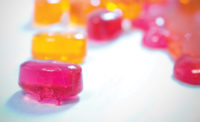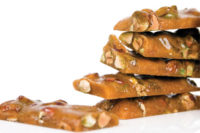The advent of sugar, first chewed by the peoples of New Guinea and then successfully crystalized by the Indians during the Gupta dynasty in 350 A.D., proved key to the evolution of sweets, and with it, the role fruits play in a broad range of confectionery products.
The combination of fruits and sugars initially were treasured for their therapeutic value more than their pleasurable and preservative qualities. Ironically, it’s a marriage that remains valid today. Consider the comments made by Sandra Martinez de Arévalo, senior v.p.–confectionery at Nestlé in an interview that appeared last December in Nutfruit Magazine, a publication of the International Nut and Dried Fruit Council.
“There are two significant trends sweeping across the confectionery world,” she points out. “The first is ‘premiumization,’ as consumers in both developed and developing countries are willing to pay higher prices for unique tastes and experiences. The second is towards healthier eating, where the consumer is looking for all the great taste but in a product format that is ‘better for them’ than existing products on the market.”
Naturally, and this means literally naturally, fruits play a critical role on both fronts. As Martinez de Arevalo notes, the industry is seeing the growth of “many new ‘healthier’ products which emphasize wholesome ingredients such as fruit and nuts, either inside the product or (even better) prominent on the packaging so that they can be seen by the consumer. We only see this trend continuing. The whole industry is reshaping its portfolio. Manufacturers are acting and they have a good understanding of what the consumer is looking for. The challenge is to fit it into their existing manufacturing footprints or brand portfolios.”
When asked what trends does she see regarding fruits and confections, Martinez de Arevalo underscored the tremendous global variety there is for confectioners to choose from.
“Across the world different fruits and nuts are enjoyed in different regions,” she says. “It is likely that manufacturers will increasingly try to cross-fertilize some of these ingredients into different regions to see how consumers react. We should also expect the growth of ‘superfruits,’ which are more exotic and enable differentiation and premiumization.”
As has been the case for many years now, the consumer wants it all. And superfruits seem more than capable of delivering on both accounts.
Take for example, Montmorency tart cherries, which are a U.S.-grown superfruit sourced from small family orchards. According to the Cherry Marketing Institute (CMI), there are more than 60 research studies linking Montmorency tart cherries to an array of important health benefits – including sleep, inflammation, heart health and exercise recovery – that can offer a nutritional halo to confections.
In addition, Montmorency tart cherries are abundant in anthocyanins, a natural compound that contributes to the ruby-red color and distinctive sour-sweet taste. This phytonutrient, a type of flavonoid, is one of the keys behind the tart cherry’s potential health benefits, CMI says.
Another health plus, Montmorency tart cherries, have one of the highest sources of phenolic compounds, specifically anthocyanins, which have been shown to fight inflammation, help reduce risk for arthritis and gout, promote cardiovascular health and aid muscle recovery and reduce oxidative stress in athletes, the Institute adds.
Moreover, the cherries combine flavor and functional versatility, enhancing sweet, spicy flavors while blending well with dark chocolate. They also are provide a natural way to help bind dry ingredients, increase moisture and create texture. Because they have low water activity, the cherries can be used in low-moisture snacks and confections.
Better-for-you offerings are exactly what fueled SuperFoods Cocoa Mocha COFFEEBERRY chocolate bar, which features coffee fruit extract. As Andy Wheeler, corporate director of marketing for FutureCeuticals, which supplies the patented COFFEEBERRY, explains, coffee fruit is high in antioxidants and enhances energy.
What once was discarded during the harvesting of coffee beans, is “the superfruit of all superfruits,” he explains. Interest in fruits in general continues to grow, says Wheeler, who also works for Von Druen Farms, FutureCeuticals’ sister company. Thanks to processing improvements, mango as well as other tropical fruits are popular, he adds.
Aronia berries, or chokeberries as they are known in North America, are another superfruit gaining popularity, particularly in Europe and Asia. Derek Socik, managing director of Kandy, the largest supplier of candied fruits in Poland, says interest in this superfruit has been growing, even prompting the company to start sourcing organic aronia berries in 2016.
Although grown in the United States and many other parts of the world, Poland also happens to be the largest producer of aronia berries (80 percent). Socik also points out that the aronia berry is hardy and resistant to weather and disease without the aid of any fungicides or chemicals.
As with the Montomrency tart cherries, clinical studies indicate that aronia berries, consumed on a regular basis, help fight neurological diseases, cancer, aging, inflammation, diabetes and bacterial infections. They also have the highest antioxidant capacity among other berries and any other kind fruit. Part of the significance of antioxidants stems from their ability to protect body’s cells from the damaging effects of oxidation.
Although Socik admits that the appeal of aronia berries is that of a very specific market, health-driven and premium, it has become the fastest growing segment for the company.
Kandy also supplies “candied fruits” to a broad range of confectionery and bakery companies. It is a “luxurious product,” one that continues to have appeal spanning hundreds of years. Moreover, thanks to new technology, what once took two weeks of processing now only takes 12 hours.
“Essentially you are replacing the water in fruit, through slow cooking, with sugar,” he explains. Polish confectionery companies such as Wedel and Solidarnosc use candied fruit, particularly plums and cherries, for some of their leading sweets.
Another ancient fruit-filled confection, pates de fruits, also appears to be gaining traction. Take Maui Epicure, which had its roots in Hawaii. Cofounders Lin and Chris ter Horst moved to Hawaii in 2012 and found themselves overwhelmed by the islands’ abundance and variety of fruit.
Lin, a former Le Cordon Bleu pastry arts graduate, began to experiment making pates de fruits. Her colorful, jewel-like fruit gems contained 50 percent fresh fruit by weight, with flavors that seem to literally explode in the mouth.
To maximize the appreciation of their dazzling colors, the ter Horsts’ Maui Jewels are not smothered in granulated sugar, a French custom to prevent sticking, but instead are individually wrapped and then packaged in clear plastic boxes.
In 2014, the ter Horsts were awarded a SOFI silver in the confectionery category for their Hana Collection Pates de Fruits at the Summer Fancy Food Show in New York City.
In a recent followup on the company, Chris Lin ter Horst revealed that Maui Epicure has indeed experienced significant growth since 2014.
“We acquired custom packaging equipment that allowed us to have one-year shelf-life for our fruit confections,” he says. “We also just launched a new product line, Hawaii Fruit Paste in July 2017, similar to the quince paste that Europeans are familiar with.
“As for your question regarding the impact of the ‘better-for-you trend’ in food’ - it has certainly helped us in many ways ,” he adds.
Fruit, of course, reimagined and recreated through a confectionery format, continues to play its historic and signature role in delivering indulgence and goodness.










